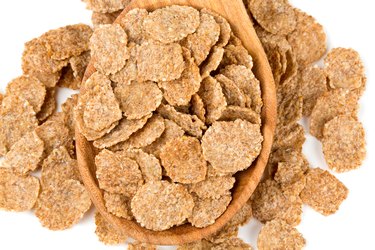
If you're looking for an easy strategy to help you lose weight, replacing your usual cereal with a high-fiber type such as wheat bran flakes may be it. Adding more dietary fiber can help people lose weight.
However, having bran cereal for breakfast doesn't mean it's OK to eat chips and candy bars the rest of the day, because a healthy diet works best for weight loss. If you have any digestive issues, check with your doctor before adding wheat bran cereal to make sure it's a good dietary strategy for you.
Video of the Day
Video of the Day
Read More: The All-Bran Diet
Do you want to lose weight or be healthier? Join MyPlate Calorie Counter and get access to free meal plans, healthy recipes and at-home workouts. You'll also get daily calorie and macro goals for your fitness journey. Don't miss your chance for amazing results. Sign up today!
Bran Flakes for Weight Loss
As a source of whole grains and fiber, wheat bran flakes make a good choice whether you're eating them as a meal or snack. However, it's important to do a little research before selecting your healthy cereal.
A good wheat bran cereal should have 100 percent whole wheat listed as the first ingredient, and contain at least 5 grams of fiber and less than 8 grams of sugar per serving, according to the University of California at Berkeley School of Public Health.
Additionally, all calories count when it comes to weight loss, so be mindful of how much cereal you're eating and its calorie content. One cup of wheat bran flakes contains 120 calories, according to the USDA.
Consider the Benefits of Fiber
Getting more fiber in your diet is a simple tool that is as effective at helping with weight loss as the low-fat American Heart Association diet, according to a February 2015 study published in the Annals of Internal Medicine. Volunteers in this study —which included people with obesity, high blood pressure, high blood sugar and high cholesterol — were asked to follow the AHA diet or simply eat 30 or more grams of fiber a day.
While the AHA diet followers lost a little more weight over the year-long study — 5.9 pounds versus 4.6 pounds — the researchers note that a simple change such as increasing your fiber intake can be useful in helping with weight loss.
As a high-fiber food, a bowl of wheat bran flakes in the morning can give you a great start to getting more fiber each day. A couple of ways that fiber in food may help with weight loss is by adding bulk, so you feel full faster, and by delaying how fast your stomach empties, keeping you feeling full longer. One of the wheat bran benefits is fiber — one serving of wheat bran cereal provides five grams of fiber, according to the USDA.
Read More: The Benefits of Oat Bran
Dressing Up Your Cereal
To keep calories under control when you're trying to lose weight, pay attention to what type of milk you add to your cereal. Nonfat milk, with 91 calories a cup, makes a better choice than whole milk, which has 149 calories a cup. If you can't tolerate cow's milk, unsweetened almond milk makes a low-cal choice, with 39 calories per cup.
If you like your cereal sweet, you might add a spoonful or two of sugar to your flakes, but 1 tablespoon of granulated sugar adds 45 calories, 12 grams of sugar and no fiber, according to the USDA. On the other hand, sliced fruit adds natural sweetness to your bowl of cereal along with some extra fiber.
One cup of sliced strawberries adds only 50 calories and 3 more grams of fiber. To really pack in the fiber, consider raspberries, which have 64 calories and 8 grams of fiber per cup, according to the USDA.
Reduce Overall Calories
While eating cereal can help people lose weight, it works best when part of an overall healthy weight-loss diet. A good weight-loss plan helps you reduce calorie intake without cutting major food groups or severely restricting your calories.
This means eating not only cereal, milk and fruit, but also vegetables, lean sources of protein such as poultry, fish and beans, and healthy fats such as olive oil and nut butters. A good weight-loss plan also limits your intake of non-nutritious foods such as cookies, cakes, fast food and soda.
- Annals of Internal Medicine: "Single-Component Versus Multicomponent Dietary Goals for the Metabolic Syndrome: A Randomized Trial"
- University of California at Berkeley: "Berkeley Wellness Letter: How to Buy Cereals"
- USDA National Nutrient Database: "Bran Flakes Whole Wheat Multi-Bran Cereal"
- USDA National Nutrient Database: "Pure Cane Granulated White Sugar"
- USDA: "Unsweetened Sliced Strawberries"
- USDA National Nutrient Database: "Raspberries, Raw"
- USDA National Nutrient Database: "Milk, Nonfat, Fluid, with Added Nonfat Milk Solids, Vitamin A and Vitamin D (Fat Free or Skim)"
- USDA National Nutrient Database: "Whole Milk"
- USDA National Nutrient Database: "Beverages, Almond Milk, Unsweetened, Shelf Stable"